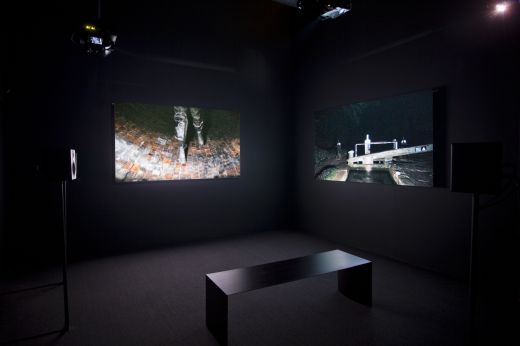
Marcellvs L., Slow Ontology. Installation view at CIFO, 2014. Courtesy of the Cisneros Fontanals Art Foundation. Photo by Oriol Tarridas.
CIFO: September 2 – November 5, 2014
Fleeting Imaginaries is CIFO’s twelfth exhibition of artists funded through its granting program. The title describes the fluctuating, porous notion of a culturally specific sensibility, fitting for a show that brings together artists from seven different countries across Latin America, and yet the show is striking in its visual and conceptual cohesion. Seemingly chance coincidences of overlapping imagery and ideas occur repeatedly throughout the works in the show. Of course, the idea of a distinct cultural imagination is increasingly sublimated in a globally connected world characterized by diaspora and displacement. The problem with increasing interconnectedness is a reduction of linguistic and symbolic variation and hence a gradual homogenization of possible meaning in the face of creeping hegemonies.
Linguistic reduction is the method of Pablo Accinelli’s wall texts installed in various locations throughout the space, but he has actually challenged the notion that such reduction shrinks the imagination. Using a typeface and a computer program he developed that systematically removes elements of certain letters depending on their location in a given word, Accinelli spells out the lyrics from various reggae songs, encouraging us to use our imagination and memory to reconstruct the letters. There is only one right answer, but by activating memory needed to reconstruct the letters, the work stimulates the imaginative impulse. The disparity between the reductive visual component and the tropical lyrics is strangely evocative. Visually the austere text pieces have a compelling visual rhythm. The abstracted letters bear a similarity to Martin Boyce’s stylized text works, and both artists language conjures dreamy imagery. Boyce has often found beauty in a vacated Modernism, and perhaps we can theorize that Accineli also urges us to continue to imagine utopia.
Text as a sculptural component also appears in Nayarí Castillo’s installations along with objects that seem like archeological relics and augment her own dreamlike vignettes. Bending around corners, traveling in various trajectories over a wall, or tracing a circle on the floor, the text expands the reader’s temporal experience of the narrative into spatial relationship. Castillo’s language recalls popular writings made in the 19th and early 18th centuries by scientists and anthropologists documenting their global exploration and observations. Her short fictions are based on her own journeys to various scientific landmarks. They often possess a sentimental nostalgia for a past on the brink of a wondrous future.
Museological signifiers are also used by other artists in the show. Mateo Pizarro places his drawings and accompanying texts in vitrines to highlight their source in early exploration of the Americas. In a willful act of slippage, Pizarro uses his own fantastical drawings to illustrate actual appropriated zoological descriptions, blending scientific inquiry with fantasy. The writings are accounts of animals found in the “New World,” like tree sloths and humming birds, while Pizarro’s drawings, which remain faithful to the text, are fantastical creatures that recall the inventions of Lewis Carroll. One can fault some of the original writers for their overactive imaginations (which were perhaps exaggerated to increase their own foundational support) but what Pizarro succeeds in evoking is the sense of wonder in an era at the beginning of a great global expansion, a feeling that has seemingly ended with a subsequent downsizing of the limits of possible realities,
Echoing the journeys of such explorers, “Slow Ontology,” a video installation by Marcellvs L., consists entirely of a slow boat journey down canals between Birmingham and Manchester. Here, however, the camera, fixed firmly forward, records a journey that follows a rigidly delineated path through the known. The shot is sumptuous and hypnotic, and L. slows us down to ponder the nature of being in a finite world.
The catalogue to Fleeting Imaginaries simply states that the nine artists were invited to install their work, and it is pleasing to imagine an installation collectively orchestrated by the artists and the foundation. At any rate, the participants’ artistic concerns and strategies of display have melded in a tightly constructed and thoughtful exhibition.










